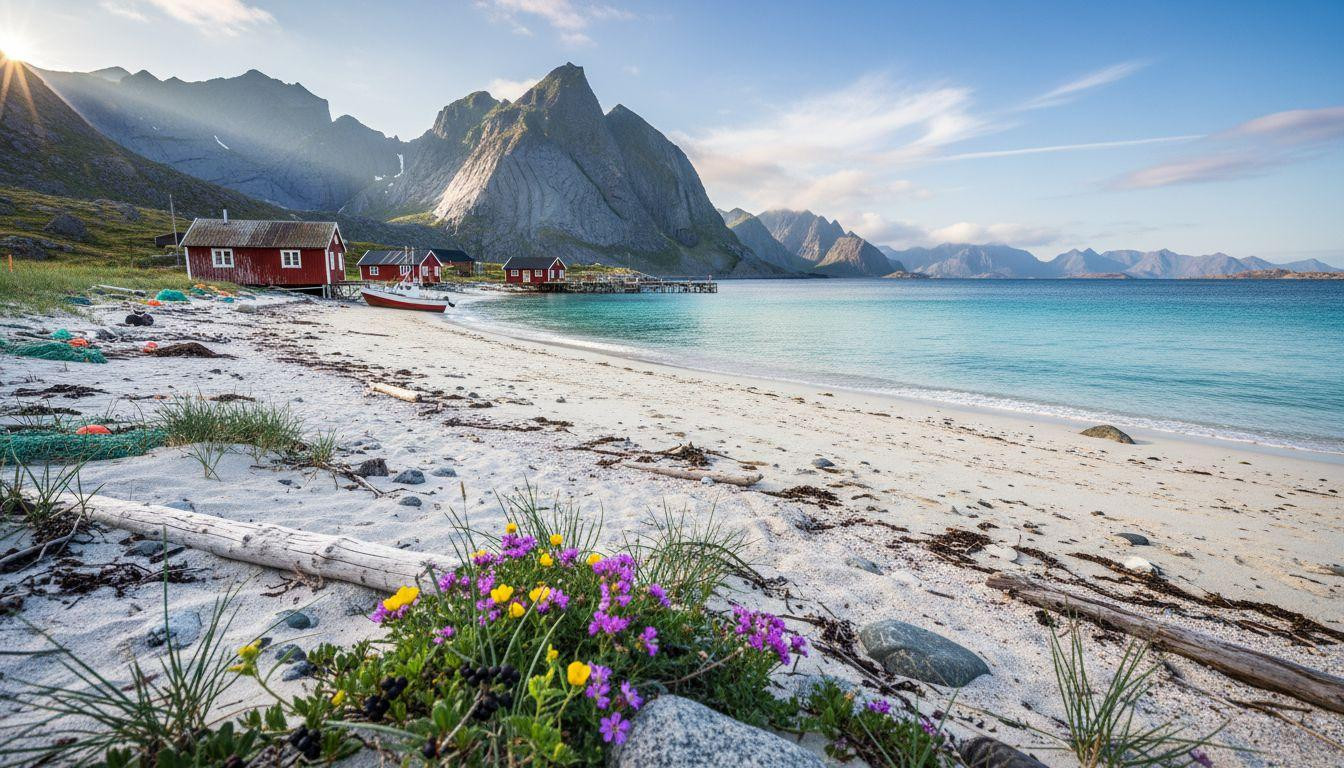Picture yourself standing on white sand at 2 AM while the sun hovers above the horizon, casting golden light across turquoise Arctic waters. Sommarøy, a tiny Norwegian island home to just 300 residents, has declared itself “time-free” during the midnight sun season. Here, clocks disappear from May through July, and life follows the rhythm of endless daylight. This Arctic paradise challenges everything you think you know about beach destinations, offering Caribbean-quality scenery at 69 degrees north latitude.
Welcome to the Arctic Caribbean
Sommarøy sits 50 minutes southwest of Tromsø Airport, connected to the mainland by a series of short bridges. The island’s GPS coordinates (69.644°N, 18.110°E) place it firmly above the Arctic Circle. Yet its beaches rival any tropical destination with crushed coral-white sand and startlingly blue water.
The midnight sun phenomenon lasts 70 consecutive days here, from May 18 to July 22. During this period, residents remove public clocks and embrace what locals call “time-free living.” Restaurant servers work when hungry guests arrive. Fishermen cast nets when conditions look right. Tourists kayak at 3 AM simply because the light feels perfect.
Arctic waters maintain temperatures of 50-59°F even in summer, requiring mental preparation but rewarding brave swimmers with exceptional clarity. Visibility extends 30-50 feet underwater, surpassing most Caribbean destinations. Traditional red fishing cabins dot the coastline, creating Instagram-worthy contrasts against white sand and turquoise water.
Seven Arctic beaches that shame the tropics
Beyond Sommarøy, northern Norway harbors six additional beaches that deliver Caribbean visuals without palm trees or tourist crowds. These destinations span 250 miles of coastline from Tromsø to the Lofoten archipelago.
The Lofoten quartet
Haukland Beach (68.1°N) offers fine white sand in a shallow turquoise bay, backed by granite peaks rising 3,000 feet from sea level. Uttakleiv Beach, 15 minutes away, creates the most photographed Arctic beach scene in Norway. Its crescent of white sand sits perfectly framed between twin mountain peaks.
Skagsanden Beach maintains consistent surf conditions year-round, with locals organizing midnight sun beach volleyball tournaments in July. Water temperatures can reach 77°F on exceptional summer days. Nearby, Myrlandshaugen Beach offers complete seclusion, with traditional fishermen’s cottages available for overnight stays on stilts over clear blue water.
Hidden gems of Senja and Vesterålen
Ersfjordstranda Beach on Senja Island requires a one-hour ferry crossing from Sommarøy but rewards visitors with dramatic fjord scenery surpassing even St. Lucia. Wild camping remains legal here, allowing overnight beach stays under the midnight sun.
Bleik Beach on Andøya stretches 2 miles of uninterrupted white sand, hosting 100,000 puffins on offshore islands. Whale watching tours from nearby Andenes village achieve 90% sighting rates for orcas and humpback whales from May through September.
The economics of Arctic paradise
Daily costs in northern Norway average $330-470 per person, including mid-range accommodation ($180-250), restaurant meals ($80-120 for dinner for two), and activities like whale watching or kayaking ($70-100). Caribbean destinations typically cost $670-1,030 daily, creating genuine savings of 50% or more.
Accommodation at Sommarøy Arctic Hotel starts at $149 nightly, including sauna access and beachfront location. Traditional rorbu fishing cabins in Lofoten rent for $120-180 per night. Budget travelers can find guesthouses for $100-140 throughout the region.
Transportation between beaches requires rental cars, with Tromsø to Lofoten taking 3 hours via the scenic E10 route. Internal Lofoten drives between beaches range from 15-45 minutes. Ferry connections link Sommarøy to Senja ($35-45 for car plus passengers) and operate year-round as of 2025.
Arctic sensations that tropics cannot match
The sensory experience of Arctic beaches transcends visual beauty. Sand composed of crushed seashells creates different textures underfoot than tropical coral sand. Arctic air carries scents of seaweed, wildflowers, and clean glacial runoff. Sea eagles call overhead while gentle waves lap against pristine shorelines.
Swimming requires courage but delivers spiritual rewards. The initial shock of 50-degree water gives way to invigorating clarity that many describe as transformative. A 5mm wetsuit enables extended water activities, from kayaking hidden coves to snorkeling among Arctic marine life.
Local cuisine emphasizes fresh seafood including cod, salmon, and Arctic char. Lofoten’s stockfish (air-dried cod) holds UNESCO recognition for its thousand-year production heritage. Cloudberries, known as “Arctic gold,” appear in desserts throughout the region. Traditional recipes passed down through fishing families create authentic cultural experiences unavailable at resort destinations.
Your questions about Arctic beaches answered
How cold is swimming in Arctic water really?
Arctic water temperatures of 50-59°F feel shockingly cold initially but become refreshing after 2-3 minutes of acclimatization. Local guides recommend gradual entry and 5mm wetsuits for extended activities. Many visitors describe the experience as spiritually cleansing, comparing it to Nordic wellness traditions. The exceptional water clarity (30-50 feet visibility) compensates for temperature challenges.
When do Northern Lights appear over these beaches?
Aurora borealis viewing season runs September through March, with peak activity from October to February. The same beaches offering midnight sun in summer provide front-row seats for Northern Lights in winter. Sommarøy, Haukland, and Bleik beaches rank among Norway’s top aurora viewing locations due to minimal light pollution and clear northern horizons.
How do Arctic beaches compare to Scotland’s Highland coast?
Both regions offer white sand and turquoise water at northern latitudes, but Norwegian beaches provide more consistent sunshine during summer months. Scotland’s Achmelvich Beach resembles Lofoten’s scenery but lacks the midnight sun phenomenon. Arctic Norway’s fishing village authenticity surpasses Scotland’s more developed coastal tourism infrastructure. Costs remain similar between both destinations.
November brings the first aurora displays to these beaches as early winter settles across the Arctic. The same pristine white sand that reflects endless summer sun will soon mirror green and purple lights dancing across polar skies. Arctic beaches offer year-round magic that tropical destinations simply cannot match.
